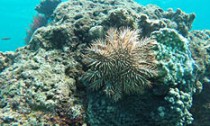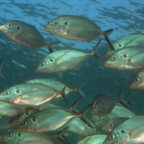
The crown of thorns starfish which has devastated large areas of the Great Barrier Reef has infested areas around the Montebello Islands off the Pilbara coast.
Surveys going back to the mid-1970s have shown the existence of the marine invertebrates in the reefs off the Pilbara coastline. However, the numbers being currently observed are much higher than seen in previous years.
Dr John Keesing is the Senior Principal Research Scientist with the CSIRO in Perth and has recorded 185 animals per hectare.
“Above about 10 crown of thorns starfish per hectare will cause noticeable damage on coral reefs.” he told ABC Mid West and Wheatbelt.
Though the numbers are high in Western Australia, they are certainly not as high as those seen on the Great Barrier Reef.
For Dr Keesing, who began studying the marine menace 30 years ago on the Great Barrier Reef, it’s good to revisit an old foe.
He says the main problem in the North West of WA is that the infestation follows the very large reduction in live coral cover caused by bleaching from warmer water temperatures.
“Since the coral cover has been reduced to such low levels in the areas around the Montebello Islands and Barrow Island, even the moderate densities of the crown of thorns starfish that is being witnessed at the moment is causing significant coral mortality.”
Moving on?
Close monitoring is underway with particular emphasis on the possible migration of the voracious predator of live coral to other areas of the WA coastline.
“Crown of thorns starfish has always been present on Ningaloo Reef, but our main concern is that you may get transport of their larvae from the Montebello Islands down towards Ningaloo.
“The coral here is in an exceptionally good state and if there were large outbreaks it would do significant damage to the reef.”
Crown of thorns starfish have also been observed in very low numbers on the Abrolhos Islands, off the coast of Geraldton.
Safe for now
“The islands are way south. It would be fair to say the animal is very rare in the region, though it has been seen there.
Typically in high latitude coral reefs like the Abrolhos where temperatures are cooler particularly during winter, you don’t tend to get large numbers of crown of thorns starfish,” Dr Keesing said.
So what can be done to prevent the southward migration of the starfish from the Pilbara to Ningaloo?
“We can do all the things that help keep coral reefs healthy in the first place, making sure we’re not damaging them and are using them sustainably,” encourages Dr Keesing.















Social Profiles